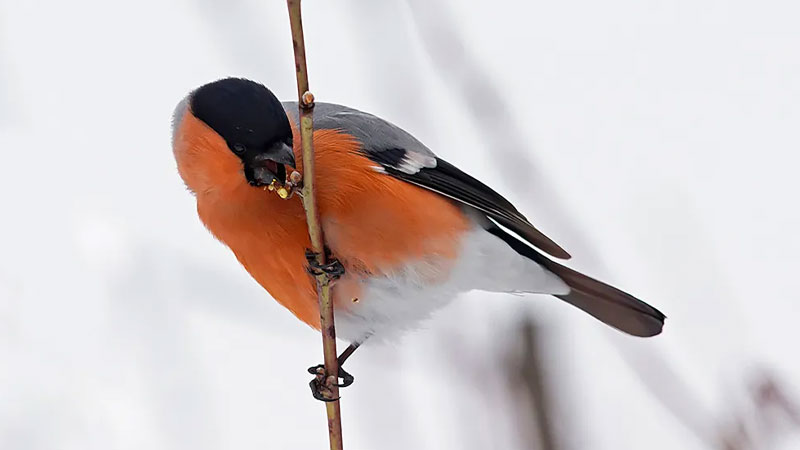Eurasian Bullfinch
Pyrrhula pyrrhula (Linnaeus 1758)
Photo: © Mathias Putze

Appearance:
A rather secretive, large finch almost the size of Hawfinch. Short but thick beak and clumsy overall appearance.
Adult males are bright rosy-red with a grey mantle, wings, tail and crown are black. Adult females are clearly duller, more brown or dusky pink with an even darker blueish mantle. Both sexes have distinct broad white wingbars. Brownish juveniles lack the black cap.
Natural History:
The Eurasian Bullfinch is widespread in Europe and Palearctic Asia.
It feeds on a variety of seeds, buds, shoots and invertebrates.
Eurasian Bullfinches are rather shy and rarely visit bird feeders. The most frequently heard call is a only little variable, soft whistle, not unlike a human whistle. That’s why it’s easy to lure. However, this call shows a broad variation over the whole range of distribution. Northeastern taxa wintering in Central Europe are immediately recognisable by their different ‘trumpet call’, and have earned them the nickname “Trumpeter Bullfinch”. Pairs or small flocks are very vocal whilst foraging.
Like the Hawfinch, the song appears to be a sequence of social calls, intermingled with sequences of more complex elements and phrases.
Bullfinches are migratory birds and form flocks of up to 30 individuals both on migration and in the wintering areas.
Taxonomy:
Pyrrhula pyrrhula pileata
-> British Isles
Pyrrhula pyrrhula pyrrhula
-> N, SC and E Europe to C Siberia
Pyrrhula pyrrhula europaea
-> W Europe
Pyrrhula pyrrhula iberiae
-> SW France, N Iberian Peninsula
Pyrrhula pyrrhula rossikowi
-> NE Turkey and the Caucasus
Pyrrhula pyrrhula cineracea
-> W Siberia and NE Kazakhstan to E Siberia and NE China
Pyrrhula pyrrhula caspica
-> Azerbaijan and N Iran
Pyrrhula pyrrhula cassinii
-> E Siberia
Pyrrhula pyrrhula griseiventris
-> Kuril Island and N Japan
Pyrrhula pyrrhula rosacea
-> Sakhalin Island
Object of study:
Call types, dialects in social calls.
Flight Call:
Known social call types (not formally described so far):

PFR06849, 28/12/2011, Greifswalder Oie, Germany, Patrick Franke

PFR05857, 07/05/2011, Dzukhey, Kazkhstan, Patrick Franke

PFR10385, 27/12/2014, Gollwitz, Germany, Patrick Franke



